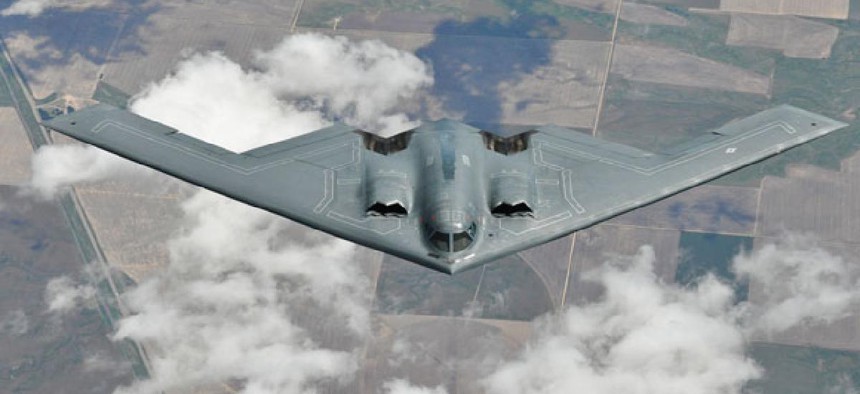
The Air Force has planned on a next-generation successor to its B-2 bomber. United States Air Force
Sequestration endangers new bomber, Air Force secretary warns
Michael Donley says 'every program would be affected if sequestration were to hit.'
The head of the U.S. Air Force on Friday said his service hopes to keep plans for developing a future strategic bomber on track in the face of looming budget cuts, but he suggested the project's future could be in question if federal sequestration takes effect.
The Air Force hopes by the mid-2020s to start receiving the new bombers, which are intended to gradually replace the service's aging B-1 and B-2 aircraft. The Pentagon has indicated it wants to design and build between 80 and 100 of the aircraft designed to carry nuclear bombs.
"Long-term, we're committed to the Long-Range Strike Bomber," Air Force Secretary Michael Donley told reporters at the Pentagon. "We're going to try to keep programs like that on track, but every program would be affected if sequestration were to hit."
A "fiscal cliff" plan signed into law on Jan. 2 delayed by two months a set of mandatory, across-the-board spending cuts previously set to take effect at the start of this year under the 2011 Budget Control Act. The scheduled reductions would slash funding for most Pentagon programs by nearly one-tenth.
Defense Secretary Leon Panetta on Thursday announced his department would develop plans to implement the sequestration curbs and would immediately eliminate nonessential spending to soften their blow if Congress fails to reach a cancellation agreement.
The "near-term actions cannot fully mitigate the impacts of sequestration should that occur," Donley warned. "If we do not have resolution by March, sequestration will have immediate and negative impacts on Air Force readiness, specifically flying hours and maintenance."
"As Secretary Panetta has reiterated, the focus now must be on taking the threat off the table and enacting a budget agreement that will stabilize defense planning for the remainder of [fiscal year 2013] and the years ahead," the official added.
Air Force Chief of Staff Gen. Mark Welsh said "we can be confident that the defense budgets will shrink, but how far remains to be seen."
The fiscal 2013 defense authorization law enacted this month requires the planned aircraft to be ready to accommodate nuclear bombs immediately upon becoming operational, and to be certified to host such armaments within 24 months of the initial milestone.
Donley said the Air Force is "in a much stronger place than [it was] a few years ago" in managing its nuclear weapons. The service unified its nuclear missile and bomber operations in 2009 under the new Global Strike Command and undertook various other reforms following a series of mishaps that included a mistaken 2006 shipment of nuclear missile fuses to Taiwan and an accidental 2007 flight of six nuclear-armed cruise missiles across several U.S. states.
The service has rolled out "more rigorous inspection processes [and] put in place much more intensive oversight ... to help us get unified management over this capability," Donley said.
"We've worked very hard through the Nuclear Weapons Center and Air Force Materiel Command to get very close alignment between operations and sustainment," he added. "So I think we've made considerable progress in our oversight of the nuclear enterprise."
Donley said his service is "in the midst of implementing" a bilateral strategic arms control accord with Russia. The New START agreement requires the United States and Russia to by 2018 each cap their arsenals of deployed long-range nuclear weapons at 1,550 warheads and 700 delivery systems.
The service is making "preparations for adjusting the size of the bomber force, and also planning for adjustments in the size of the ICBM force," Donley said. "We're doing the advance planning that goes with START implementation," he added without elaborating.






